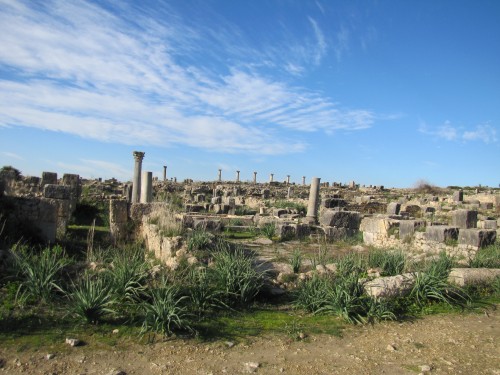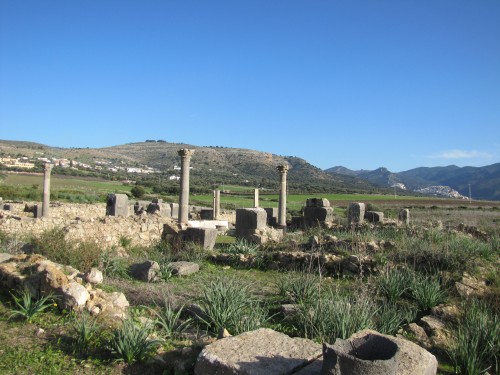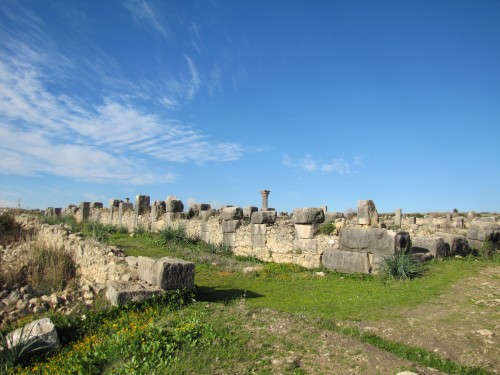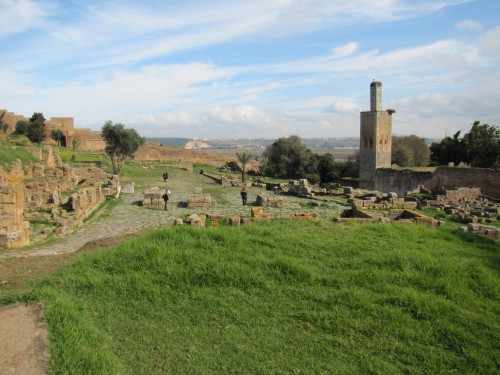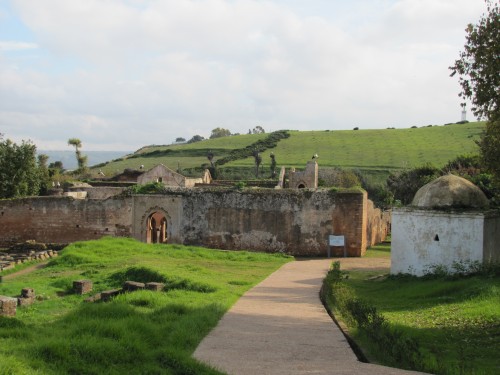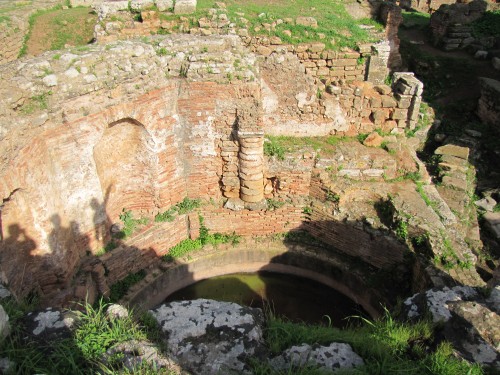Roman ruins, Volubilis, Morocco
After leaving Meknes we travelled on towards Fes, stopping along the way to visit the ancient ruins of the Roman town of Volubilis. This UNESCO World Heritage site turned out to be one of the highlights of our trip for me – one out of many highlights, I might add. Before this, I had no idea that the Romans had once occupied a part of what is now Morocco. I knew from my studies in history that their empire was extensive, but never realised it had extended so far west in Africa.
We had several hours to wander around the extensive site, our guide giving us an excellent insight into life in those times. The town, once with about 20,000 inhabitants, was settled in the third century BC by the Pheonicians. Under Roman rule in the first century AD it thrived as a trading centre set in the fertile farming around around it. It eventually became the cultural and administrative centre of that part of Morocco, until the seat of power moved to Fes in the 11th century. The town existed for at least another 700 years, first as a Christian settlement and later Islamic.
You can read more of its extensive history here.
Over coming days I will share many more photos of this amazing place.
Sala Colonia Roman ruins, Chellah, Rabat, Morocco
I have lived all of my life in Australia. Our country has a long and ancient heritage in our Aboriginal history, but nothing in the way of ancient buildings. The Aboriginal rock carvings are often millennia old and totally absorbing as such. Because of their lifestyle, the Australian Aboriginal people did not need to build impressive buildings like we see in Europe, Africa and other parts of the world.
So when we visited Morocco we naturally marvelled at the age of some of the old Roman ruins. Our guides were meticulous in relating the historical significance of places like these Roman ruins of Sala Colonia in Rabat. I was not aware before this of the Roman influence on life in Morocco.
Totally fascinating.
More photos coming tomorrow.
Inneston, Yorke Peninsula
During our recent short holiday on Yorke Peninsula we visited the Innes National Park. It had been many years since our last visit to this scenic and rugged part of the South Australian coast. In the middle of the national park is the historic town of Inneston. The village was once the home to over 150 people and was a bustling, industrious town.
The town was established in 1913 to house the miners working in the nearby gypsum mines and production factory. Many of the local salt lakes were rich in the mineral which was transported mainly to Adelaide via Stenhouse Bay. In the state capital city it was used primarily in the building trade.
After the mine closed the town rapidly deteriorated as people moved away. In more recent times some of the original buildings have been restored and are used as accommodation in the national park.
You can read more about the history of this town on the Flinders Ranges Research site here.
Scenes of Pinnaroo, South Australia
When I visited Pinnaroo in eastern South Australia recently I realised I had never actually driven into the the town, nor had a good look around. Normally we have just driven past without stopping; the main road by-passes most of the town. I must admit that I was pleasantly surprised.
Pinnaroo appears to be a vibrant rural town with many fine facilities and a good feel about it. I did stop for a morning tea treat from the local bakery. Outlets like this in country towns in Australia are always worth checking out. I was not disappointed; my chocolate coated donut was delicious.
Just like so many country towns in Australia, Pinnaroo boasts several beautiful buildings, including the two pubs shown on this post. I didn’t have the time nor the inclination to test out what they were like inside. Knowing the kind of hospitality such towns exude in abundance, I’m sure I would have been made most welcome.
Bendigo Post Office, Victoria
Bendigo is a beautiful regional city in a lovely rural setting in the central north of Victoria. It is situated about an hour and a half drive from Melbourne along a modern freeway.
Bendigo has a rich and colourful history, built initially on the gold mining which brought great wealth to the area. Now it is a regional centre, tourist destination and boats many beautiful old buildings of the Victorian era.
One of those beautiful buildings is the historic old Bendigo Post Office, shown in the photos on this page. For more details of this building click here.
